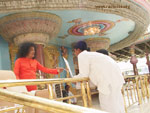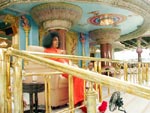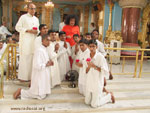|
THE DIVINE ESSENCE OF VEENA
The establishment of the Sai Mirpuri College
of Music has added a new dimension to the Ashram life. Verily
music is the highest form of devotion, through which God is
most easily obtained. The musician not only redeems his own
life through his music, but also carries the listeners along
with him to divine ecstasy. Indian classical music is very
devout and God-centered and generates in one and all Bhakthi
Bhava or divine love consciousness.
 So
it is no wonder that the occasions when the students of the
Music College play for the Lord are most enjoyable and pleasing.
The students not only play on formal occasions like Thyagaraja
Aradhana or on special festival days, but also enthrall
the Lord on a lazy afternoon with an impromptu concert in
Sai Kulwant Hall. On Wednesday, March 10, 2004, the students
of the Music College presented a veena concert that provided
immense pleasure to the Lord and all the devotees present. So
it is no wonder that the occasions when the students of the
Music College play for the Lord are most enjoyable and pleasing.
The students not only play on formal occasions like Thyagaraja
Aradhana or on special festival days, but also enthrall
the Lord on a lazy afternoon with an impromptu concert in
Sai Kulwant Hall. On Wednesday, March 10, 2004, the students
of the Music College presented a veena concert that provided
immense pleasure to the Lord and all the devotees present.
Playing as they did at the end of the academic
year, it was also an occasion for them to fully present to
the Lord, who is also the Chancellor of the Sri Sathya Sai
Institute of Higher Learning to which the Music College is
affiliated, what they had imbibed during the academic year
and earn His approval and Grace.
The Veena, a
musical instrument from South India, has played a leading
role in the development of Indian music. Carnatic music (as South Indian
Classical music is called) regards the veena
as God’s gift to humanity. The belief is that the veena
music takes us to cosmic consciousness. The veena
nada or sound kindles the fire in the kundalini
that lies curled up in the mooladhara
chakra, the lowest of the six nerve centers that lie
along the spinal column. The vibration set in motion by the
body heat and the life breath gathers momentum as it travels
up the spinal column, eventually releasing immense powers
of concentration and meditation leading to cosmic consciousness.
This is known as Nadopasana,
and is considered to be the easiest path to salvation.
Carnatic music (as South Indian
Classical music is called) regards the veena
as God’s gift to humanity. The belief is that the veena
music takes us to cosmic consciousness. The veena
nada or sound kindles the fire in the kundalini
that lies curled up in the mooladhara
chakra, the lowest of the six nerve centers that lie
along the spinal column. The vibration set in motion by the
body heat and the life breath gathers momentum as it travels
up the spinal column, eventually releasing immense powers
of concentration and meditation leading to cosmic consciousness.
This is known as Nadopasana,
and is considered to be the easiest path to salvation.
The students started their concert with Vatapi
Ganapathim Bhajeham; a piece in Hamsadwani
composed by Dikshithar, a famous poet sage of South India.
In India all auspicious tasks are begun with an invocation
to Lord Ganapathi, the Lord who removes all obstacles along
the path and ensures success.
It is only through ceaseless practice that
a Vainika or veena
player acquires mastery over this musical instrument. This
practice enables him to acquire a clear intellect, a steady
mind, and control over the senses, a sweet voice and absolute
freedom from fear of any kind. Swami also has on occasions
extolled the qualities of a veena
player. Thus the study of the veena
is itself sadhana.
 The
second song played was Endaro Mahanubhavulu.
It is said that a great musician Shatkala Govinda Marar from
Kerala once approached Sri Thyagaraja and sang in front of
him. The composition was sung in six speeds. Thyagaraja appreciating
the genius of this musician composed this musical piece, Endaro
Mahanubhavulu, in his honor. The
second song played was Endaro Mahanubhavulu.
It is said that a great musician Shatkala Govinda Marar from
Kerala once approached Sri Thyagaraja and sang in front of
him. The composition was sung in six speeds. Thyagaraja appreciating
the genius of this musician composed this musical piece, Endaro
Mahanubhavulu, in his honor.
The veena itself
is considered to be divine. The veena
dandi or the stem represents Shiva, the seven strings
represent His consort Paravathi, the dragon head- Vishnu,
the bridge represents Lakshmi, the metal cone – Saraswati,
and the resonator represents the creator Brahma. In recognition
of these Gods being represented in one instrument, the students
next played Brahmam Okate, God
is one, in Bhoopalam. This was
followed by a composition called Marubalkakunnavemera
in Sri Ranjani.
The veena finger technique is dynamic and
is capable of producing a wide range of sounds. Relatively
easier to learn, it still takes two decades to become a successful
veena player. But the students of the Music College, seem
to make very rapid progress in a fraction of the time, even
in just a year or two, entirely due to His Grace.
The virtuosity of the veena was brought forth
in full by the next piece Ninnu Vina
Namadendu (in Namarasa Kannada),
a piece eminently suitable for instrumental music. This had
everyone in Sai Kulwant Hall in raptures.
The short concert concluded with the instrumental
rendition of the Vedic hymn –
the Mantra Pushpam. This Mantra
Pushpam expounds the truth that from the Atma,
the Self, first emerged the sky. From the sky came air; from
the air emerged fire; from the fire, the water; and from the
water emerged the earth. Thus the source of the all the 5
elements (i.e. the material creation) is the one single Atma.
Similarly, whatever may be the system of
music, whatever may be the theories, technicalities, skill
and traditions of a particular system of music, still all
systems of music emanate from Him. Music thus is a divine
art and brings about Divya Ananda
or happiness in everyone’s heart and peace in everyone’s
mind, and makes everyone feel near to God.
Swami, we are very grateful to You for establishing
the College of Music. The devotion and dedication of these
students elevates our devotion also and establishes You firmly
in our hearts and minds and makes us feel very close to You.
|